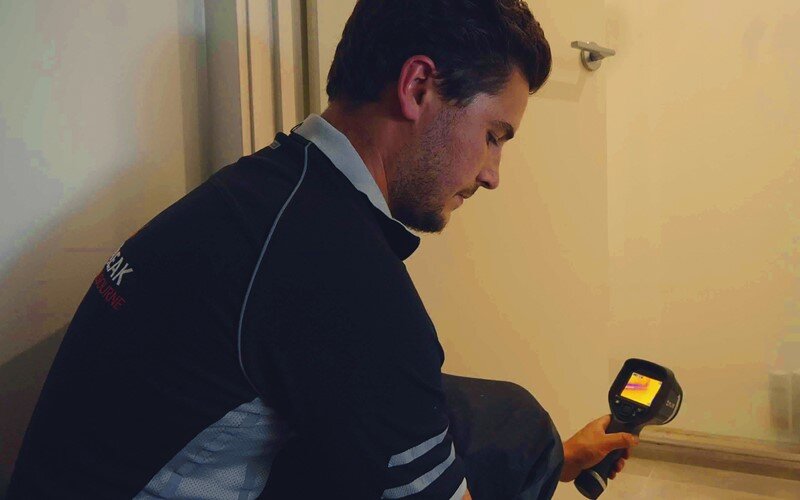How to Inspect If Your Residence Has a Covert Leakage
How to Inspect If Your Residence Has a Covert Leakage
Blog Article
The article in the next paragraphs relating to Leaking water lines is absolutely attention-grabbing. Give it a try and draw your own personal ideas.

Early discovery of leaking water lines can mitigate a potential disaster. Some little water leaks might not be noticeable.
1. Examine the Water Meter
Every house has a water meter. Checking it is a proven way that assists you discover leakages. For starters, switch off all the water sources. Make certain nobody will certainly purge, use the faucet, shower, run the cleaning device or dish washer. From there, go to the meter and watch if it will change. Considering that no one is utilizing it, there ought to be no motions. If it moves, that indicates a fast-moving leakage. If you find no modifications, wait a hr or 2 and also check back once again. This implies you might have a slow leak that might even be underground.
2. Examine Water Usage
If you find sudden modifications, regardless of your usage being the same, it means that you have leakages in your plumbing system. An unexpected spike in your bill suggests a fast-moving leak.
A steady rise every month, even with the very same behaviors, shows you have a sluggish leakage that's also slowly rising. Call a plumber to completely inspect your residential or commercial property, specifically if you feel a cozy area on your flooring with piping beneath.
3. Do a Food Coloring Examination
30% comes from bathrooms when it comes to water intake. Test to see if they are running appropriately. Decline specks of food shade in the container as well as wait 10 mins. There's a leak in between the tank and bowl if the color somehow infiltrates your dish throughout that time without flushing.
4. Asses Exterior Lines
Don't fail to remember to check your exterior water lines too. Needs to water permeate out of the link, you have a loose rubber gasket. One tiny leakage can throw away lots of water and also increase your water bill.
5. Analyze the scenario and also inspect
House owners should make it a practice to examine under the sink counters as well as even inside cabinets for any kind of bad odor or mold development. These 2 red flags indicate a leak so timely interest is called for. Doing routine inspections, also bi-annually, can conserve you from a major issue.
Inspect for discolorations and also weakening as many appliances as well as pipes have a life span. If you presume leaking water lines in your plumbing system, don't wait for it to rise.
Early discovery of leaking water lines can mitigate a potential disaster. Some little water leaks may not be visible. Inspecting it is a guaranteed method that aids you find leaks. One tiny leakage can squander loads of water and increase your water costs.
If you believe leaking water lines in your plumbing system, don't wait for it to escalate.
WARNING SIGNS OF WATER LEAKAGE BEHIND THE WALL
PERSISTENT MUSTY ODORS
As water slowly drips from a leaky pipe inside the wall, flooring and sheetrock stay damp and develop an odor similar to wet cardboard. It generates a musty smell that can help you find hidden leaks.
MOLD IN UNUSUAL AREAS
Mold usually grows in wet areas like kitchens, baths and laundry rooms. If you spot the stuff on walls or baseboards in other rooms of the house, it’s a good indicator of undetected water leaks.
STAINS THAT GROW
When mold thrives around a leaky pipe, it sometimes takes hold on the inside surface of the affected wall. A growing stain on otherwise clean sheetrock is often your sign of a hidden plumbing problem.
PEELING OR BUBBLING WALLPAPER / PAINT
This clue is easy to miss in rooms that don’t get much use. When you see wallpaper separating along seams or paint bubbling or flaking off the wall, blame sheetrock that stays wet because of an undetected leak.
BUCKLED CEILINGS AND STAINED FLOORS
If ceilings or floors in bathrooms, kitchens or laundry areas develop structural problems, don’t rule out constant damp inside the walls. Wet sheetrock can affect adjacent framing, flooring and ceilings.
https://www.servicemasterbyzaba.com/blog/how-to-detect-water-leakage-in-walls/

I came across that blog entry on Leaking water lines when doing a search on the web. Sharing is good. Helping people is fun. We value reading our article about Finding hidden leaks.
Report this page